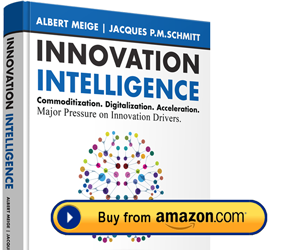This article is the fifth and final one of the series about Innovation Waves, after Innovation Waves Associated With Invention and Discovery, Time Sequence for Innovation Waves and Their Applications : the GPS Example, How Kodak Missed The Turn…, and Knowledge Distribution During an Innovation Wave.
Early strategic phase: knowledge acquisition to mitigate risks
At the onset of a potentially fruitful innovation project, many companies need access to a portion of the relevant new knowledge while performing their minimum duty, roadmapping. This includes strategically evaluating the potential impact of the new invention or discovery on the company’s current business and then defining if, how, and when the company should introduce the new concept into its innovation pipeline. By definition, the invention or discovery is new, so the relevant knowledge is confined to a narrow circle of a few pioneering laboratories. The relevant knowledge is absent from most companies.
However, there may be one exception: a start-up firm that has just been spun off from a laboratory that played a key role in the invention or discovery. Indeed, such a start-up would have an advantage over its competitors due to its capability to more easily and rapidly put the new knowledge to use.
Aside from this hypothetical spun-off start-up firm, the rest of the industry would face a knowledge deficit. Several approaches are currently used for rapidly acquiring knowledge during the early phases of an innovation wave:
- Engage a consultant who is expert in the new field. Make sure that he or she is qualified in terms of both technical knowledge and headquarters confidence and is not working with any of your competitors. Secure a solid confidentiality contract with the consultant and foster the relationship between the consultant and your company’s executives. You may want to use a stepwise approach such as the Presans process described in its website.
- Assign one or more internal engineers to learn about the new invention or discovery. Such an approach requires allocation time and budget to activities such as reading scientific papers, visiting laboratories, and attending international conferences on the topic. All knowledge-acquisition processes bear some risk. For example, a consultant may be too driven by his or her own enthusiasm to spot treacherous obstacles. In addition, a consultant may not be reliable in terms of confidentiality even after signing a confidentiality agreement.
The consulting option is faster than the self-learning option. The cost of self learning is far from negligible. A company that chooses the self-learning option will have to make an often painful trade-off between spending more time learning, which will delay a decision, or making an early decision based on only a partial understanding.
Note that for the strategic early phase we have excluded the option of hiring an expert as an employee. At such an early stage, because the company does not yet know if it will incorporate the new concept, it would be too risky to hire an employee and integrate him or her into the company.
Technology entry: knowledge acquisition for fast time to market
When a company knows enough about a new invention or discovery has decided to pursue it, the company needs to acquire operational knowledge in the new field in order to make its time to market as brief as possible. As already stated, self learning is possible but slow and costly. The required operational knowledge is not widespread but rather is still confined to research laboratories. Hiring experts as employees is the fastest option. In fact, large conferences on particularly hot topics have an unofficial function as hiring offices. In the United States, a large company that wants to hire experts in a new field frequently rents a suite in the hotel at which the conference is taking place and offers refreshments and on-the-spot interviews to interested candidates. For example, at the onset of the blue LED innovation wave, several companies that attended key meetings of the Materials Research Society (MRS) followed this approach to hiring the best specialists in compound-semiconductor crystal growth. A few years later, when the first steps of LED technology had been done, the same companies attended the American Physical Society (APS) conferences, looking for experts on Maxwell-equation 3-D modeling in order to address the next steps.
Also during this phase, a company may need assistance in determining which knowledge is the most suited to its purpose and therefore which research area should be the highest priority. The recommended approaches for acquiring this guidance are the same ones recommended for the early strategic phase.
We should remind you that, even if an invention or discovery is certain to affect a company’s business, there is an excellent alternative to acquiring the full knowledge by hiring experts: the company can partner with a company that has already the proper knowledge. The two companies can agree to share the knowledge, and perhaps even future effort, to develop new products.
This approach, Open Innovation, is probably the most efficient and flexible. However, it requires that both companies have some high-level skills in terms of collaboration and setting up contracts. When relying on open innovation, a company is not exempt from the need to integrate a solid understanding of the invention or discovery, at least at a strategic level. Indeed, it is impossible to conceive and conduct a successful collaboration with a partner company without having someone in-house who understands the value generated by the new concept and has a positive feeling about the required innovation-related efforts
***
This article was initially published in the book Innovation Intelligence (2015). It is the third section of the third chapter.
From decision to action
The Conciergerie helps you engage on demand top level experts for industrial innovation



